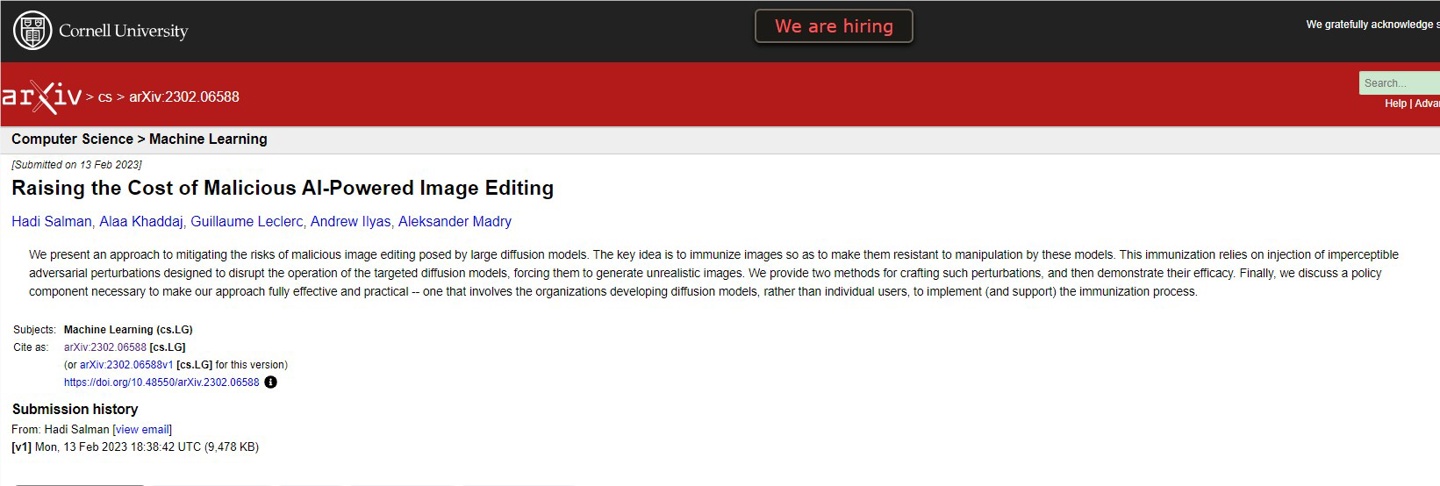 Technology peripherals
Technology peripherals
 AI
AI
 MIT develops 'PhotoGuard' technology to protect images from malicious AI editing
MIT develops 'PhotoGuard' technology to protect images from malicious AI editing
MIT develops 'PhotoGuard' technology to protect images from malicious AI editing

As AI-based deepfakes technology continues to advance, it is becoming increasingly difficult for people to judge “which content is AI forged” through the naked eye. In order to prevent images from being misinterpreted after being modified by crawlers, MIT recently announced a technology called Photoguard, which can process images to make them difficult to be recognized and tampered with by AI

It is reported that this "PhotoGuard" technology mainly prevents AI from recognizing the image content by making slight modifications to the image. This technology provides two solutions to prevent pictures from being modified by AI. One is the "encoder" method, which interferes with the algorithm model's ability to understand the image by modifying the pixels of the image; the other is the "diffusion" method to make the AI think the picture is A is picture B, thus generating the wrong image.
However, IT House learned after inquiries that the application space of this technology is actually limited. Researchers warned that PhotoGuard technology is more suitable for anti-crawler scenarios. The technology itself also has certain limitations. Attackers only This technique can be cracked by cropping or flipping the processed image.
Researchers pointed out that to solve the problem of AI fraud, in addition to technical means, model developers, social media platforms and relevant departments also need to work together to provide a comprehensive "anti-AI fraud" solutionThe above is the detailed content of MIT develops 'PhotoGuard' technology to protect images from malicious AI editing. For more information, please follow other related articles on the PHP Chinese website!

Hot AI Tools

Undresser.AI Undress
AI-powered app for creating realistic nude photos

AI Clothes Remover
Online AI tool for removing clothes from photos.

Undress AI Tool
Undress images for free

Clothoff.io
AI clothes remover

Video Face Swap
Swap faces in any video effortlessly with our completely free AI face swap tool!

Hot Article

Hot Tools

Notepad++7.3.1
Easy-to-use and free code editor

SublimeText3 Chinese version
Chinese version, very easy to use

Zend Studio 13.0.1
Powerful PHP integrated development environment

Dreamweaver CS6
Visual web development tools

SublimeText3 Mac version
God-level code editing software (SublimeText3)

Hot Topics
 1387
1387
 52
52
 How to get logged in user information in WordPress for personalized results
Apr 19, 2025 pm 11:57 PM
How to get logged in user information in WordPress for personalized results
Apr 19, 2025 pm 11:57 PM
Recently, we showed you how to create a personalized experience for users by allowing users to save their favorite posts in a personalized library. You can take personalized results to another level by using their names in some places (i.e., welcome screens). Fortunately, WordPress makes it very easy to get information about logged in users. In this article, we will show you how to retrieve information related to the currently logged in user. We will use the get_currentuserinfo(); function. This can be used anywhere in the theme (header, footer, sidebar, page template, etc.). In order for it to work, the user must be logged in. So we need to use
 How to elegantly obtain entity class variable names to build database query conditions?
Apr 19, 2025 pm 11:42 PM
How to elegantly obtain entity class variable names to build database query conditions?
Apr 19, 2025 pm 11:42 PM
When using MyBatis-Plus or other ORM frameworks for database operations, it is often necessary to construct query conditions based on the attribute name of the entity class. If you manually every time...
 Java BigDecimal operation: How to accurately control the accuracy of calculation results?
Apr 19, 2025 pm 11:39 PM
Java BigDecimal operation: How to accurately control the accuracy of calculation results?
Apr 19, 2025 pm 11:39 PM
Java...
 How to process and display percentage numbers in Java?
Apr 19, 2025 pm 10:48 PM
How to process and display percentage numbers in Java?
Apr 19, 2025 pm 10:48 PM
Display and processing of percentage numbers in Java In Java programming, the need to process and display percentage numbers is very common, for example, when processing Excel tables...
 How to package in IntelliJ IDEA for specific Git versions to avoid including unfinished code?
Apr 19, 2025 pm 08:18 PM
How to package in IntelliJ IDEA for specific Git versions to avoid including unfinished code?
Apr 19, 2025 pm 08:18 PM
In IntelliJ...
 How do subclasses modify private properties by inheriting the public method of parent class?
Apr 19, 2025 pm 11:12 PM
How do subclasses modify private properties by inheriting the public method of parent class?
Apr 19, 2025 pm 11:12 PM
How to modify private properties by inheriting the parent class's public method When learning object-oriented programming, understanding the inheritance of a class and access to private properties is a...
 How to efficiently query large amounts of personnel data through natural language processing?
Apr 19, 2025 pm 09:45 PM
How to efficiently query large amounts of personnel data through natural language processing?
Apr 19, 2025 pm 09:45 PM
Effective method of querying personnel data through natural language processing How to efficiently use natural language processing (NLP) technology when processing large amounts of personnel data...
 What are the underlying principles and lock upgrade process of synchronized in Java?
Apr 19, 2025 pm 09:48 PM
What are the underlying principles and lock upgrade process of synchronized in Java?
Apr 19, 2025 pm 09:48 PM
Exploring the underlying principle of synchronized and the details of the lock upgrade process In Java, synchronized keyword is one of the tools used to implement thread synchronization, and its underlying...



